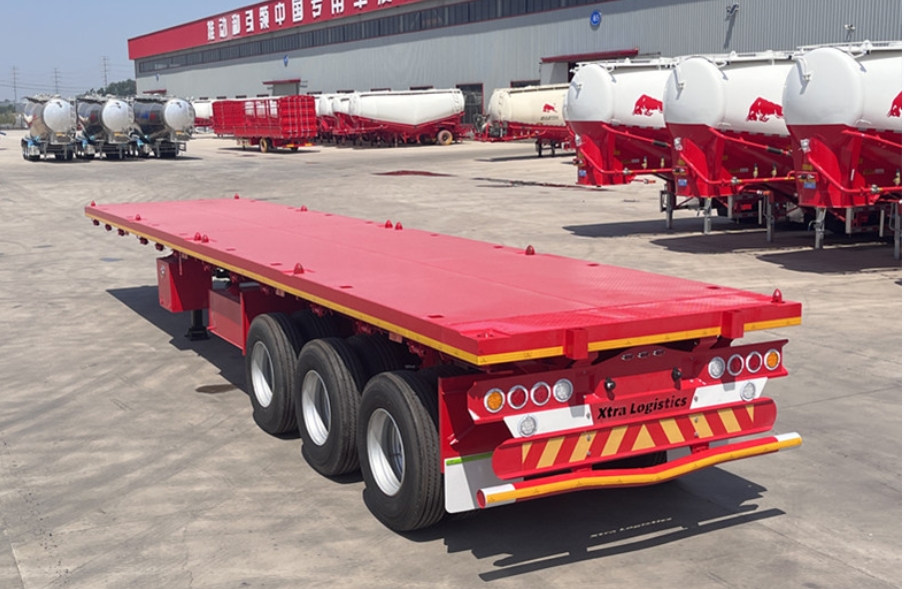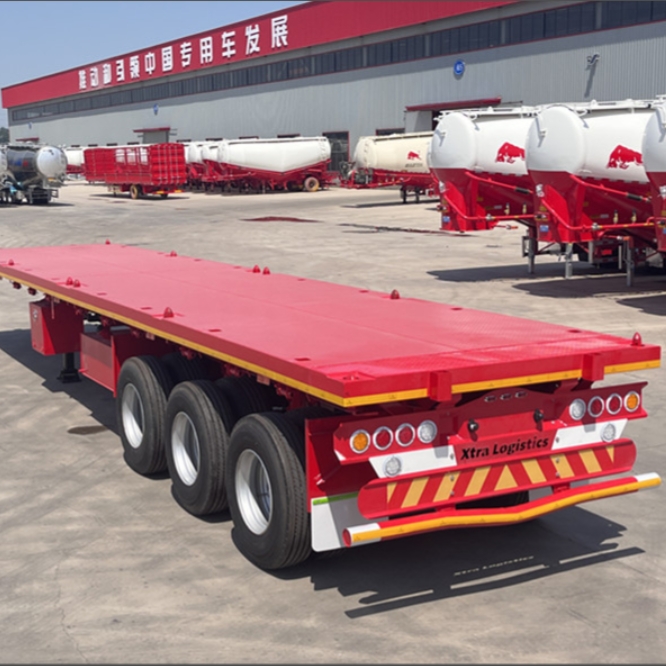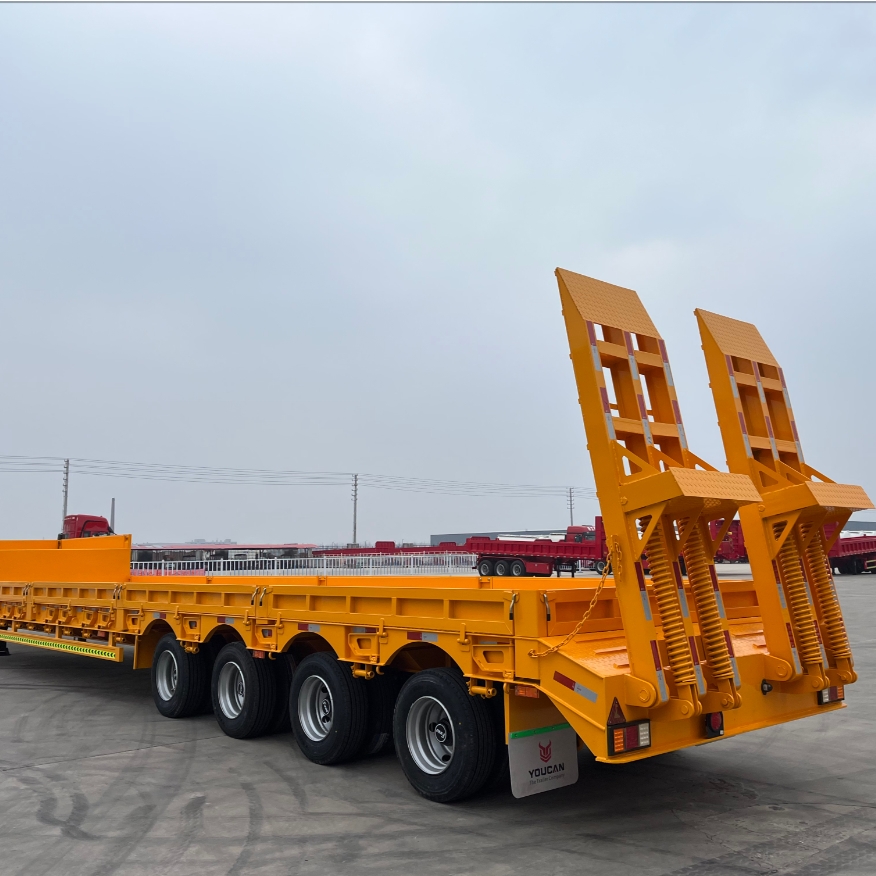2024 Best Guide of Flatbed Semi Trailer
Flatbed semi trailers(Flatbed trailers) have always played an important role in the transportation industry of various cargo types. In this comprehensive guide for 2024, we’ll explore the latest trends, features, and tips for choosing the right flatbed semitrailer, as well as purchasing and leasing options.
What is Flatbed Semi Trailer ?
A flatbed semi trailer is a versatile and efficient type of transportation equipment, distinguished by its open, level platform which lacks sides or a roof. This unique design configuration allows for the hassle-free loading and unloading of a diverse range of goods, materials, and cargo, rendering it an indispensable asset across multiple industries.
The design of flatbed semi trailers caters to the transportation of large, bulky, or oddly-shaped items that may be difficult to transport in enclosed trailers. The absence of sidewalls and a roof provides a more spacious platform and easier access to the load, facilitating loading and unloading using cranes, forklifts, or other machinery.
Flatbed semi trailers are extensively utilized across various sectors, such as construction, agriculture, manufacturing, automotive, and more. They are ideal for transporting construction materials like steel, lumber, and concrete; agricultural equipment like tractors and hay bales; and vehicles like cars, trucks, and other heavy machinery. With the range of sizes and load capacities available on the market, flatbed semi trailers can be tailored to meet specific transportation requirements and industry needs.
Overall, flatbed semi trailers offer a flexible and practical solution for transporting a wide variety of cargo, ensuring ease of handling and adaptability across diverse scenarios and industries.

3 Axle 40 FT Flatbed Semi Trailer
Features of Flatbed Semi Trailer
Flatbed semi trailers offer several essential features that make them a popular choice in the transportation industry:
Versatility: Flatbed semi trailers are suitable for transporting a diverse range of cargo types, from construction materials such as steel and lumber, to agricultural equipment, machinery and vehicles. Their open design accommodates various goods, offering flexibility for different transportation needs.
Easy loading and unloading: The open platform of a flatbed semi trailer allows for easy access from all sides, simplifying the process of loading and unloading cargo. This feature makes them particularly attractive for transporting cargo that requires a quick turnaround or frequent handling.
Range of sizes and capacities: Flatbed semi trailers come in various sizes and load capacities to accommodate different cargo dimensions and weights. This allows users to select the most suitable trailer for their specific requirements.
Durable construction: Flatbed semi trailers are built with high-quality materials, such as steel or aluminum, which provide strength and durability under various loads and conditions. This robust construction ensures that flatbed trailers can withstand the demands of transportation and remain reliable over time.
Compatibility with other equipment: Flatbed semi trailers can be used in combination with other transport equipment, including cranes or forklifts, to facilitate the loading and unloading process. This compatibility makes them a flexible solution for a wide range of logistics scenarios.
The latest types of Flatbed Semi Trailer in 2024
As the transportation industry evolves, flatbed semi trailers have advanced to cater to various cargo types and newer requirements. Some of the latest types of flatbed semi trailers include:
Common 40 ft Flatbed Semi Trailer: This standard flatbed semi trailer is typically used for transporting a wide range of cargo, such as palletized goods, construction materials, and machinery, due to its versatile design and universal size.
Side Wall Trailers: These trailers are equipped with side walls, providing extra support and security for cargo during transit. Side wall trailers are ideal for transporting goods that require additional lateral stability.
Wing Van Trailers: Featuring hinged panels on the sides that can be raised or lowered, wing van trailers allow for easy side loading and unloading of cargo, particularly useful for goods that need to be loaded with a forklift.
Flatbed Semi Trailer with Front Board: This type of trailer has a front board or headboard, offering additional support to prevent cargo from shifting forward during transportation, ensuring extra security and safety.
Extendable Flatbed Semi Trailer: Designed for extra-long cargo that exceeds the length of standard flatbed trailers, these extendable trailers can be adjusted to accommodate oversized loads such as long steel beams or wind turbine blades.
Drawbar Flatbed Semi Trailer: These trailers feature a drawbar coupling for easy connection and disconnection from towing vehicles. They are particularly useful for smaller cargo loads that don't require a full truck and trailer combination.
Superlink Trailers: Superlink trailers consist of two flatbed trailers connected via a dolly, allowing for the transport of multiple stacked containers or large, palletized goods, providing increased hauling capacity.
Lowbed Trailer: Also known as lowboy or low loader trailers, lowbed trailers have a lower deck height to accommodate taller and heavier cargo such as heavy machinery and equipment.
Detachable Low Bed Trailer: These trailers come with removable goosenecks or detachable necks, allowing the front of the trailer to be lowered to the ground, simplifying the process of loading and unloading heavy equipment by driving it onto the trailer.
Applications of Flatbed Semi Trailers
Flatbed semi trailers are widely used across various industries and applications due to their versatility and ease of loading and unloading. Some common applications of flatbed semi trailers include:
Construction: Flatbed semi trailers are commonly used for transporting steel, lumber, concrete slabs, and other building materials to and from construction sites.
Agriculture: In the agricultural sector, these trailers are used for carrying farming equipment, hay bales, irrigation systems, and even livestock in some cases.
Auto transport: Flatbed semi trailers can be used for shipping cars, trucks, and other vehicles. They can transport a single or multiple vehicles depending on the size of the trailer and the arrangement of the load.
Industrial equipment: These trailers are essential for moving large machines or components between manufacturing plants or production facilities.
Energy and infrastructure: Flatbed semi trailers are often used to transport materials and equipment for large-scale projects such as wind farms, solar arrays, or infrastructure builds like bridges and tunnels.
Heavy machinery: Heavy equipment such as excavators, bulldozers, and cranes can also be transported on flatbed semi trailers as needed.
How to selecting the Right Flatbed Semi Trailer?
When selecting the right flatbed semi trailer for your transportation needs, several factors must be considered to ensure the most suitable and efficient solution. Here's a step-by-step guide to help you make an informed decision:
Analyze your cargo: Begin by evaluating the nature of the cargo you plan to transport. Consider its dimensions, weight, and any specific loading or unloading requirements. Flatbed semi trailers come in various sizes and load capacities, so understanding your cargo's characteristics will help you choose the appropriate trailer.
Consider legal requirements and restrictions: Research the regulations and permits required for your specific cargo and route, checking for any weight, height, and width restrictions that may be in place. Each region may have unique transportation rules and limitations; understanding these will help you avoid potential fines or penalties.
Determine trailer features: Identify any specific features you may need, such as extendable trailers for oversized cargo, drop-deck trailers for taller loads, or curtain-sided trailers for additional cargo protection. Assessing your requirements will help you narrow down your options to the most suitable trailer types.
Factor in distance and road conditions: Take into account the distance and road conditions of your planned route. Longer trips or rough terrains may necessitate a more durable trailer built to withstand the journey. Additionally, consider height restrictions on roads and bridges that may affect your choice.
Establish your budget: Set a budget that covers your flatbed semi trailer purchase, maintenance, insurance, and other associated costs. Weigh the long-term benefits against the upfront and ongoing expenses to ensure you are making a cost-effective decision.
Research manufacturers and suppliers: Investigate various flatbed semi trailer manufacturers and suppliers, reviewing their product quality, customer service, warranty, and after-sales support. Look for reviews and testimonials from previous customers to evaluate their reputation and reliability.
Flatbed Semi Trailer for sale
Flatbed semi trailers are available for sale from numerous manufacturers, dealers, and online marketplaces. When looking to purchase a flatbed semi trailer, consider the following steps:
Identify your requirements: Determine the specifications, features, and size of the flatbed semi trailer needed for your transportation tasks based on your cargo characteristics, legal requirements, and budget.
Research manufacturers: Investigate various flatbed semi trailer manufacturers, comparing their product quality, customer reviews, and after-sales support. Look for a manufacturer with a solid reputation for producing durable and reliable trailers.
Compare dealers and suppliers: In addition to researching manufacturers, it is important to compare dealers and suppliers regarding the range of flatbed semi trailers they offer, their pricing, and their customer support.
Request quotes: Contact multiple manufacturers, dealers, or suppliers, and request quotes for the flatbed semi trailers that meet your requirements. Ensure that the quotes include not only the purchase price but also any additional costs such as delivery fees, taxes, and potential customization charges.
Consider financing options: If necessary, explore financing options for purchasing a flatbed semi trailer. Many dealers and manufacturers offer financing solutions, either in-house or through partnerships with financial institutions, to help customers spread the cost of purchasing a trailer over time.
Evaluate warranty and service offerings: Before making a purchase, scrutinize the warranty and service offerings provided by both the manufacturer and the dealer. A comprehensive warranty and accessible, responsive customer service are crucial for a worry-free experience after the purchase.
Inspect the trailer before purchasing: If possible, inspect the flatbed semi trailer in person before finalizing the purchase. This allows you to assess the build quality and condition of the trailer and address any potential concerns.
Flatbed Semi Trailer for Rent
If you require a flatbed semi trailer for a short-term or one-time project, renting a flatbed trailer can be a cost-effective and flexible solution. Numerous rental companies offer flatbed semi trailers for rent, catering to various needs, cargo types, and duration requirements. Here are some factors to consider when renting a flatbed semi trailer:
Assess your requirements: Determine the size, load capacity, and specific features needed for the flatbed semi trailer based on your cargo's characteristics and transportation requirements.
Compare rental companies: Research and compare different trailer rental companies regarding their available trailer options, rental terms, and pricing. Look for customer reviews and testimonials to gauge their reputation and the quality of their trailers.
Examine rental terms and conditions: Review the rental terms and conditions, including the rental duration, mileage restrictions, insurance coverages, and any maintenance or repair responsibilities. Ensure you understand the agreement and its implications before committing to a rental.
Inspect the trailer: Before renting, thoroughly inspect the flatbed semi trailer for any signs of damage, wear, or potential safety issues. Verify that the trailer meets your requirements and is in suitable condition for the intended use.
Inquire about maintenance and support: Check with the rental company regarding their maintenance and support services during the rental period. Ensure that they offer assistance in case of breakdowns, repairs, or other issues that may arise during use.
Evaluate costs: Compare the rental costs against purchasing a flatbed semi trailer, factoring in the length of your project and the potential for future trailer needs. Renting may be more cost-effective for a single, short-term project, while purchasing could prove beneficial if you have ongoing or frequent transportation needs.
Conclusion
In conclusion, the 2024 Best Guide of Flatbed Semi Trailer provides a comprehensive overview of various aspects of flatbed semi trailers, highlighting their features, types, applications, and key factors to consider when making the right selection. As the transportation industry continues to evolve and adapt to changing demands, it's essential to stay informed about the latest trends, technologies, and best practices to ensure efficient and safe transportation of goods. By understanding the nuances of flatbed semi trailers and making informed decisions, you can optimize your cargo transport experience and meet the challenges of modern logistics with ease and confidence.

 WhatsApp
WhatsApp
 sales@youcantrailer.com
sales@youcantrailer.com
 +8615203709888
+8615203709888


